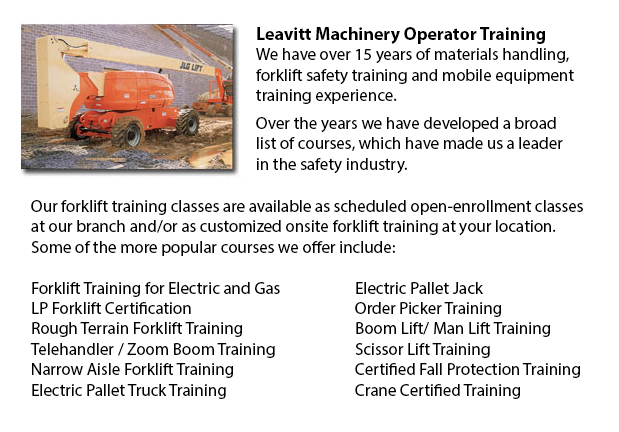
London Aerial Boom Lift Training - Aerial Boom Lift Training is required for any person who operates, supervises or works near boom lifts. This particular type of aerial lift or aerial work platform is used for lifting individuals, materials and tools in projects requiring a long reach. They are generally utilized to access other above ground job-sites and utility lines. There are different kinds of aerial booms lifts, like for instance extension boom lifts, cherry pickers and articulating boom lifts. There are two types of boom lift: "telescopic" and "knuckle".
Boom lift training is essential and normally involves the fundamental equipment, safety and operations issues. Employees are required when working with mobile machinery to know the safe work practices, rules and dangers. Training program materials provide an introduction to the terminology, uses, concepts and skills necessary for workers to acquire competence in boom lift operation. The material is aimed at safety professionals, workers and equipment operators.
For your company requirements, this training is adaptive, cost-effective and educational and will help your workplace become safer and more effective, allowing for higher levels of production. Less workplace accidents take place in workplaces with stringent safety rules. All equipment operators need to be trained and assessed. They need understanding of existing safety measures. They must comprehend and follow rules set forth by the local governing authorities and their employer.
Employers must make sure that their employees who operate aerial boom lifts get proper training in their safe use. Operator certification is required on each different type of aerial machine utilized in the workplace. Certifications are offered for aerial work platforms, articulating booms, scissor lifts, industrial forklift trucks, etc. Employees who are completely trained work more effectively and efficiently than untrained workers, who need more supervision. Correct instruction and training saves resources in the long run.
Training is the best prevention for the primary causes of workplace deaths: falls, electrocutions and collapses or tip overs. Aside from training, the best way to avoid workplace accidents is to maintain and operate aerial work platforms based on the instructions of the manufacturer. Allow for the total weight of the tools, materials and the worker when adhering to load restrictions. Never override electrical, hydraulic or mechanical safety devices. Workers must be held securely within the basket making use of a body harness or restraining belt with an attached lanyard. Do not move lift equipment when employees are on the elevated platform. Employees must be careful not to position themselves between the beams or joists and basket rails in order to prevent being crushed. Energized overhead power lines should be at least 10 feet away from the lift machinery. It is suggested that workers always assume power lines and wires may be energized, even if they are down or appear to be insulated. Set the brakes and make use of wheel chocks if working on an incline.
-
London Crane License
London Crane License - Crane operators ought to be "credentialed", that means they must possess a crane operator license or certification. Credentialing is considered a mandatory governmental requirement in order to practice as a crane operator. Obta... More -
London Heavy Equipment Operator Training
London Heavy Equipment Operator Training - Training facilities which offer quality standards in the industry and not just provide field performing tasks but added equipment training are highly sought after. Accredited schools provide students the kno... More -
Telehandler Training in London
Telescopic handlers usually referred to as telehandlers for short, are a very popular piece of heavy construction machinery. They are usually utilized in the agriculture and construction industries. These machines have maximum reaching capacity and c... More -
London Boom Lift Certification
London Boom Lift Certification - Elevated work platforms allow maintenance operations and work to be carried out at heights which could not be reached by any other means. Workers utilizing boom lifts and scissor lifts can learn how to safely operate... More -
London Fall Protection Ticket
London Fall Protection Ticket - Fall-related accidents are the number one reason of death within the construction industry. The potential for fall incidents really increases based upon the kind of work that is being completed within your workplace. T... More -
London Forklift Safety Training
London Forklift Safety Training - Anybody who wants to operate a lift truck should take a forklift safety training program to become a certified forklift truck operator. There are several ways to obtain forklift training. Programs are provided throug... More -
Operator Safety Training, Re-Qualification Training, In-House Instructor Training in London
Lift trucks are used in nearly all warehouse operations and in boat yards and in industrial construction sites. The reach feature of a forklift is a vital component used in various applications like for instance whenever a shelving system is being us... More -
London Boom Lift Safety Training
London Boom Lift Safey Training - Boom lifts are a type of elevated work platform or aerial lifting device that are commonly utilized in construction, industry, and warehousing. Boom lifts can be used in practically any surroundings due to their vers... More

Forklift Certification London
TOLL FREE: 1-888-254-6157
London, Ontario
forkliftcertificationlondon.com
Email Us
About Us


